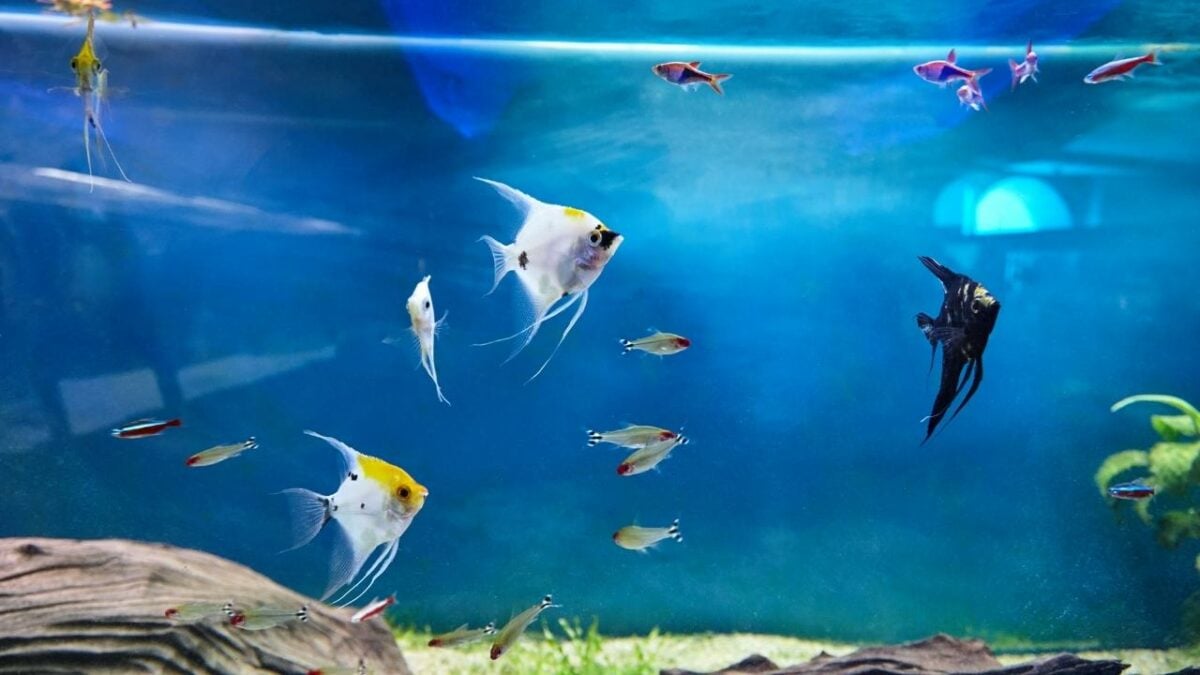
So, what makes a fish a dither fish? The key is in their behavior – they are outgoing, tend to school in groups, and often occupy the upper levels of the tank.
This, in turn, draws the attention of other fish and helps to disperse aggression. Dither fish are generally non-aggressive, compatible with different species, and should be large enough to avoid being potential prey.
I’ve included a chart at the end of this post which gives you some great dither fish recommendations for popular types of shy or aggressive fish.
What Are Dither Fish & Why You Should Keep Them?
Dither fish are introduced to an aquarium to make other fish feel more comfortable and less stressed. These little helpers are usually small and active fish that swim in the upper or middle levels of the water.
Their presence can have a positive impact on the behavior of the other fish in your tank.
They help to coax out skittish or shy fish into the open water by acting as a signal to the other fish that the environment is safe and free of predators, encouraging them to come out of hiding and display their natural behaviors.
For aggressive fish they are a source of distraction, by grabbing their attention, causing them to focus more on these new tank mates rather than on each other, helping diffuse any tension.
I prefer to use dither fish to coax out shy fish that are hiding, rather than putting them with very aggressive fish. Yes, they can help disperse aggression, but they can end up becoming target fish and getting picked on themselves, which can result in them being stressed and making them prone to illness.
Dither fish are an excellent addition to most aquariums.
How Do I Choose The Right Type Of Dither Fish For My Aquarium?
To make the best choice for your setup, consider the following factors:
Size and Temperament
Picking the correct size dither fish is very important.
Ensure that the dither fish you choose are smaller than the main fish, but not so small that they become prey or get harassed themselves.
If a fish fits in another fish’s mouth, it can become a tasty snack!
Number, Compatibility, and Dietary Needs Of The Dither Fish
The dither fish should be peaceful and compatible with the main fish.
Make sure they don’t compete for food or space, and keep them in sufficient numbers to form a school or shoal, as this will help them feel more secure.
I recommend you keep at least 8 dither fish in a group, but more is better if you have the space, the more you have the better their schooling behavior becomes.
Water Parameters
The main fish in your tank and the dither fish you are adding should have similar water requirements, such as temperature, pH, and hardness.
Tank Size, Filtration, and Decoration
Your aquarium should have adequate space, a proper filtration system, and appropriate decorations to accommodate both the main fish and the dither fish comfortably.
7 Best Dither Fish For Your Aquarium
If you’ve got a shy fish that you want to encourage out, we’ll go over some of the best dither fish options below, so that little shy fish will be swimming confidently out in the open in no time!
I’ve included the average fully grown size of each dither fish, to help you pick the most suitably sized one. Putting neon tetras in with an Oscar isn’t going to end well for the tetras!
Adding a couple of dither fish won’t work, these fish thrive in larger groups.
You need a minimum of 8 dither fish (more is better if you have the space), for them to be effective.
Here are 7 top dither fish to consider for your tank:
1. Livebearers
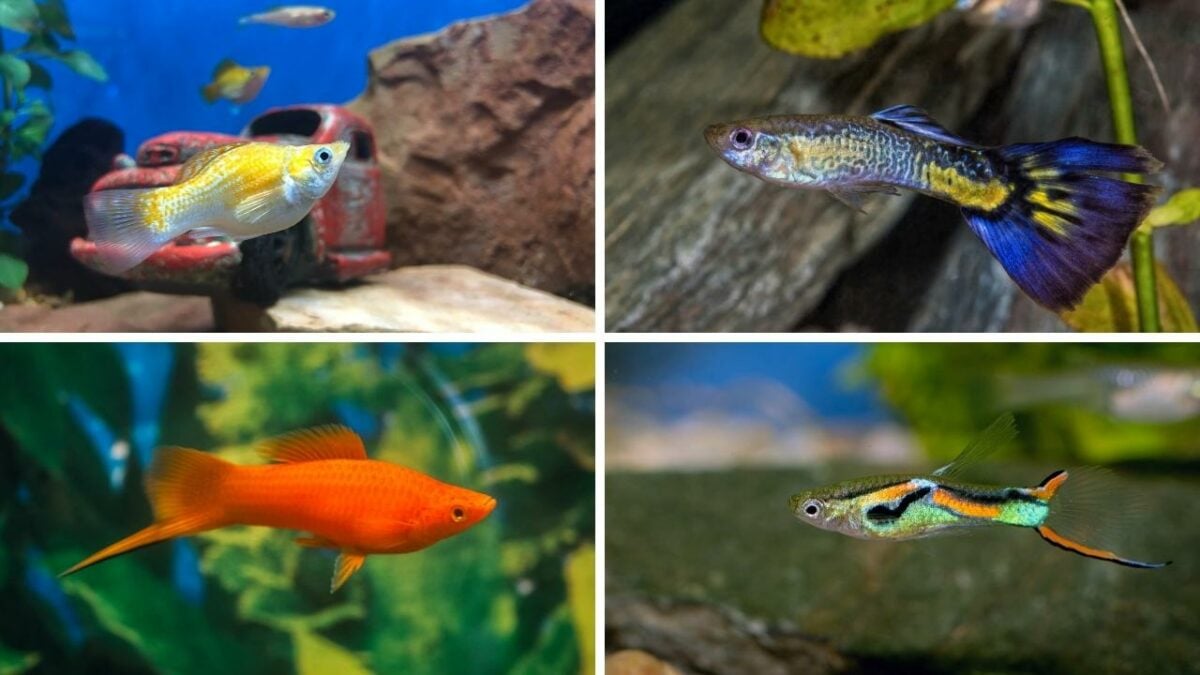
Livebearers are lively colorful fish that give birth to live young rather than laying eggs.
They are generally easy to care for, hardy, and adaptable to various water conditions, making them a great choice.
They do breed very easily and can quickly overpopulate your tank if you’re not careful. Keeping them with fish that will eat the fry is a good way to keep numbers under control or you can move the fry into a separate tank.
Some of the best livebearing dither fish are:
- Guppies (2 inches): These relatively small, colorful, and active fish come in many varieties and patterns. They are not as hardy as the other livebearers listed, due to lots of inbreeding over the years.
- Platies (2.5-3 inches): Slightly larger than guppies, platies come in a huge array of colors and are very lively. They are a great choice for beginners due to their hardy nature.
- Mollies (4 inches): Similar to platies but larger with a more elongated body shape, mollies can be kept with most community fish. Some mollies can even tolerate brackish water, making them suitable for certain brackish water tanks.
- Swordtails (4 inches excluding tail): The largest livebearer on this list. With a sword-like extension on their tail, they have a striking look. Don’t put them in with fish that may be tempted to nibble on their tail.
With livebearers, you have a variety of options for using them as dither fish in your aquarium, just ensure you manage their population.
2. Tetras

Tetras are small, schooling fish that belong to the characin family. They are usually peaceful (some can be fin nippers), colorful, and active fish that swim in the middle or upper layers of the water.
Some tetras can be a bit finicky when it comes to water parameters, so ensure your tank is fully cycled and well-established, to ensure they thrive.
Some examples of tetra species that can be used as dither fish are:
- Ember Tetra (0.75 inches): These small tetras make great dither fish in a nano aquarium. With their fiery orange color, they really stand out, especially against the greenery of a planted tank.
- Neon Tetra (1.5 inches): These are one of the most popular and iconic aquarium nano fish, with a bright blue and red stripe along their body, they look great in a large group.
- Black Neon Tetra (1.5 inches): These small silver fish have a black and yellow-green stripe running along their body. I’ve found them to be one of the most hardy tetras, making them great for beginners.
- Cardinal Tetra (2 inches): These are very similar looking to neon tetras, but larger and have a longer red stripe that extends to their tail, these fish look great in a large group.
- Rummynose Tetra (2 inches): These are mid-size tetras, with a silver body, distinctive red nose, and a black and white striped tail. They are rather sensitive to water quality and need frequent water changes, so I don’t recommend them for beginner fishkeepers.
- Congo Tetra (3 inches): One of the larger tetras, they have a lovely silvery body that shimmers with an orange stripe from nose to tail and elaborate fins.
By using tetras as dither fish, you can help alleviate stress for shy or nervous fish in your aquarium, as the tetras’ lively schooling behavior encourages other fish to come out of hiding and become more active.
Rummy nose tetras and angelfish make a great combo for a community tank.
3. Rasboras

Rasboras are small, schooling fish that belong to the cyprinid family. They’re typically peaceful, colorful, and active swimmers, preferring the middle or upper layers of the water.
Rasboras are easy to care for and hardy making them an excellent choice for beginners.
Several types of rasbora work well as dither fish.
- Chili Rasboras (0.75 inches): One of the smallest rasboras, these fish have a lovely intense red coloration, they are peaceful and a great choice nano dither fish for small aquariums.
- Harlequin Rasboras (1.5 inches): These small, sociable fish have a distinctive black patch on their rear half. These fish are an excellent choice for beginners, they are one of the hardiest fish I’ve ever kept.
- Brilliant Green Rasboras (2.5 inches): These are a popular choice mid-size rasbora, they have a lovely silvery green body with a black stripe and a splash of red on their tail. They school tightly and are very hardy making them a good choice for beginner fishkeepers.
- Scissortail Rasboras (6 inches): These guys are large by rasbora standards, scissortail rasboras feature a translucent silvery body and a caudal fin that looks and moves like a pair of scissors opening and closing. They are also available as a dwarf variety.
Overall, rasboras make excellent dither fish, adding a touch of color and activity to your aquarium while helping to create a more comfortable environment for your other fish.
If you’re looking for a friendly and charming addition to your tank, rasboras might just be the perfect choice, they are one of my favorite fish to keep.
4. Corydoras
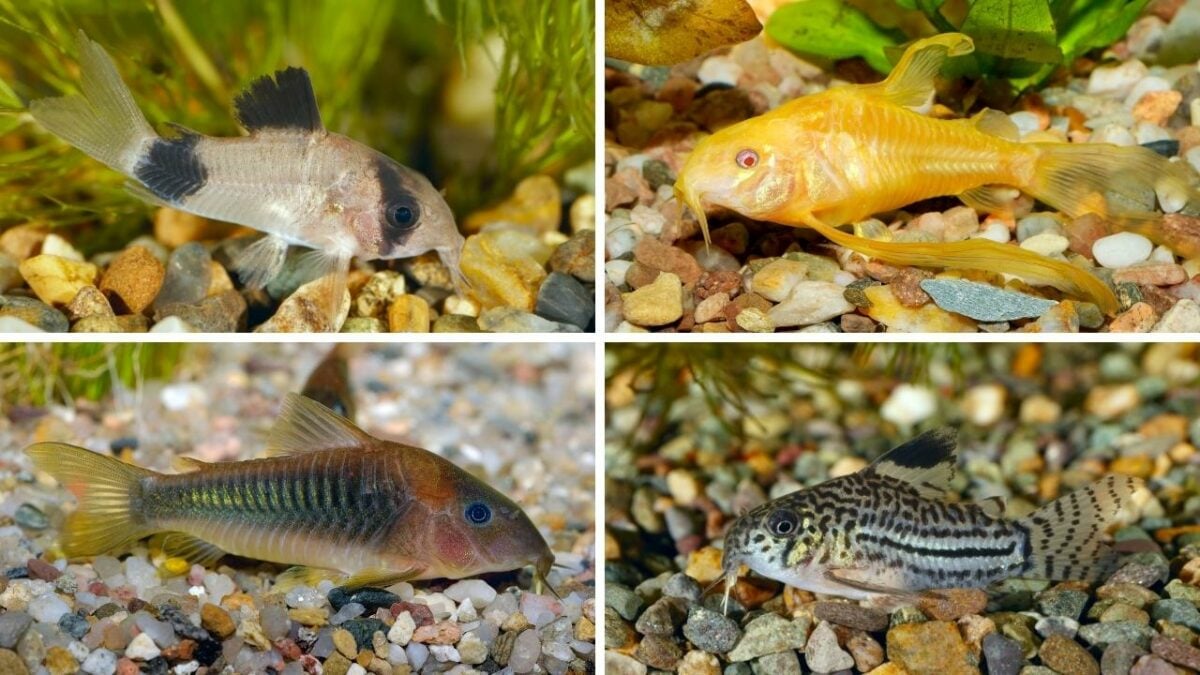
Corydoras are small, bottom-dwelling fish that belong to the catfish family. They are usually peaceful, hardy, and active fish, often seen scavenging the substrate for food.
Corys can be particularly useful if you have shy bottom-dwelling cichlids like Apistogrammas or Kribensis.
They can make excellent dither fish among other species, thanks to their non-aggressive nature, which helps calm shyer tank mates.
When introducing corydoras as dither fish, you’ll want to choose the right type for your specific tank and conditions.
Here are some examples of corydoras that can work well as dither fish:
- Panda Corydoras (2 inches): Sporting a black and white pattern that resembles a panda, Panda Corys are quite charming. They are a good choice for peaceful community fish environments and small aquariums.
- Peppered Corydoras (2.5 inches): Peppered Corys have black spots all over their body. They get along well with peaceful community fish and larger fish, as long as the larger fish aren’t overly aggressive.
- Bronze Corydoras (2-3 inches): These easy-to-care-for corydoras have a brownish body, a thick dark stripe with a green sparkle in certain lighting, and a white belly. They are a versatile choice, being suitable for peaceful community fish as well as larger fish that aren’t too aggressive.
- Emerald Corydoras (3.5 inches): With their beautiful metallic emerald green bodies and peaceful nature, these guys are a great choice of dither fish if you keep larger fish in your aquarium.
I love Cory catfish, they’re super cute, highly entertaining, and do a great job of keeping the tank bottom nice and clean.
Ensure the substrate in your tank isn’t sharp as they could scratch their bellies, fine sand or smooth gravel is the best choice for them.
5. Danios
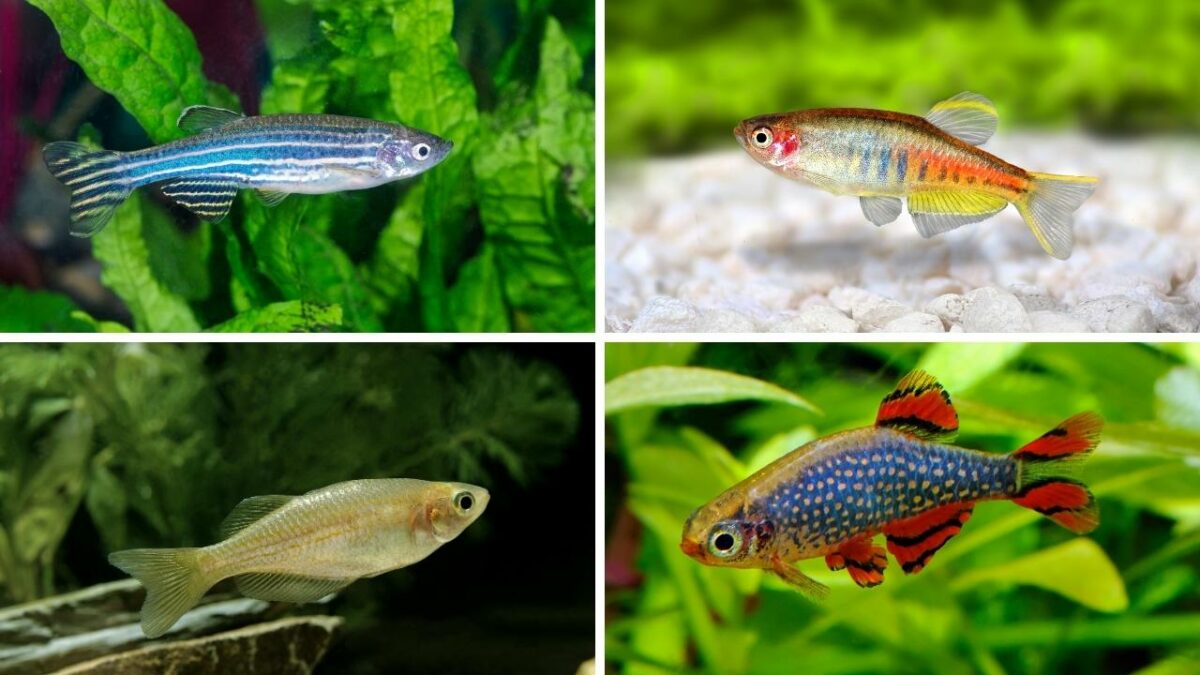
Danios are lively schooling fish that belong to the cyprinid family. They are generally peaceful, very hardy, and active swimmers, often found in the upper layers of the water.
Due to their lively behavior (some would say crazy!), they make excellent dither fish if you want to see plenty of activity in the tank, being so quick it helps them to escape from tankmates that are a little more aggressive.
Several types of danios can be used as dither fish, a few examples are:
- Celestial Pearl Danios (1 inch): Also known as the galaxy rasbora, pearl danios stay small and have an iridescent body color that makes them an attractive addition to your tank. They can coexist with peaceful community fish and larger fish that are not excessively aggressive.
- Zebra Danios (2 inches): These popular mid-size fish are easy to care for and feature a striking blue and yellow striped pattern. They are very fast swimming and will dart back and forth bringing lots of activity to your tank.
- Giant Danios (4 inches): Available in different colorations, but the most popular is golden with blue stripes. As their name suggests, these Danios are larger than their zebra and pearl counterparts. Despite their size, they are still peaceful, making them suitable as dither fish for larger fish and tanks.
Danios are known for being extremely active and playful, constantly darting around the tank in tight schooling formations. They usually grow up to 2 inches in length, except for giant danios, which grow larger.
Danios make excellent dither fish for both novice and experienced aquarists.
6. Rainbowfish

Rainbow fish are medium-sized, schooling fish that belong to the melanotaeniid family. They are generally peaceful, colorful, and active swimmers that occupy the middle or upper layers of the water.
As dither fish, they can help encourage larger shy or nervous fish to come out of hiding and provide comfort and security in the aquarium.
- Dwarf Neon Rainbowfish (3 inches): Small and vibrant, Dwarf Neon Rainbowfish are an excellent choice for a dither fish. They boast a blue-green iridescent body contrasted with red or yellow fins, adding a pop of color to your tank.
Dwarf Neon Rainbowfish can be kept with other peaceful community fish or larger tank mates that won’t see them as prey. - Boeseman’s Rainbowfish (4 inches): One of the most popular and stunning rainbow fish species is the Boeseman’s Rainbowfish. They exhibit a striking appearance with a blue front half and an orange rear half.
- Turquoise Rainbowfish (5 inches): Turquoise Rainbowfish are another fantastic option for dither fish. Their beautiful iridescent blue-green bodies create an eye-catching display.
Incorporating rainbow fish as dither fish in your aquarium can enhance the overall environment and encourage shy or anxious species to feel more at ease.
With their beautiful colors and personalities, they not only serve a functional purpose as dither fish but also add a lively and eye-catching presence to any tank.
7. Hatchetfish

Hatchetfish are small, surface-dwelling fish that belong to the Gasteropelecidae family.
They have a peculiar shape resembling a hatchet. Their unique shape and wing-like fins enable them to glide through the air and catch live insects, such as mosquitos. Because of this excellent jumping ability, a tight-fitting lid is a must!
They prefer a tank that has plenty of vegetation and some floating plants, to mimic their natural habitat.
There are a couple types of hatchetfish that you may consider using as dither fish:
- Marbled Hatchetfish (1.5 inches): Similar to silver hatchetfish, marbled hatchetfish have a more mottled pattern on their bodies (resembling marble – would you believe?!). They do well with peaceful community fish or with larger fish that won’t eat them.
- Silver Hatchetfish (2 inches): These are one of the most common and easy-to-care-for hatchetfish varieties that bring a lovely silvery shimmer to your aquarium.
Hatchetfish can serve as effective dither fish and bring some activity near the surface of your aquarium.
Most varieties of hatchetfish are still wild-caught, rather than captive-bred (buy captive-bred if you can). Ensure you quarantine them before adding them into your main tank, to prevent disease outbreaks, as they can be prone to ich.
Their unique shape, peaceful nature, and compatibility with various tank environments make them an excellent choice.
Ideal Dither Fish Combinations
Here are some examples of fish that work well together.
| Fish | Best Dither Fish Options |
| African Cichlids | Boseman’s rainbow fish or more African cichlids |
| Angelfish | Mollies, platies, rummy nose tetras, or swordtails |
| Dwarf Cichlids | Cardinal tetras, congo tetras, cory catfish, hatchetfish, harlequin rasboras |
| Discus | Cardinal tetras, cory catfish, congo tetras, rummy-nose tetras |
| Gouramis | Cory catfish, congo tetras |
| Oscar | Giant danios, large rainbow fish, silver dollars |
FAQ’S
Best Dither Fish For Discus?
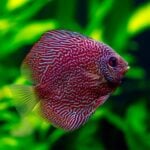
When it comes to pairing dither fish with discus, you want to choose peaceful and compatible tank mates.
Tetras, particularly the rummy-nose tetras and cardinal tetras, are popular choices due to their calm temperament and similar water requirements. Harlequin rasboras also work well.
Best Dither Fish For African Cichlids?

African cichlids can be aggressive, so it’s tricky to pair dither fish with them.
Adding more of the same type of cichlid you already have can work. If they are kept in a larger group they tend not to fight as much, but you need to be prepared to do plenty of water changes as your tank will be heavily stocked.
Boseman rainbow fish can also work well with African cichlids.
Best Dither Fish For Central and South American Cichlids (aka New World Cichlids)?

South and Central American cichlids can vary in their aggression levels, so you have to pick a dither fish to match the size and temperament.
German blue rams for example are generally peaceful, corydoras, cardinal tetras and hatchetfish can work well.
Jack Dempseys are known to be very aggressive, so you need robust dither fish, like giant Danios.
Best Dither Fish For Large Cichlids?

Large cichlids can be aggressive, so when choosing dither fish to coexist with them, go for fast, sturdy species that can hold their own.
Giant danios and silver dollars are known to work well with large cichlids, as they are quick and adaptable.
Ideal Dither Fish For Oscars?
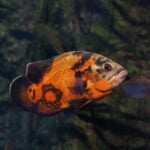
Oscars are notorious for their size and temperament, so you’ll need dither fish that can handle this type of environment.
Giant danios, large rainbowfish, tinfoil barbs, and silver dollars make excellent tankmates, given their speed, size, and relative peacefulness.
Suitable Dither Fish For Betta?

Bettas can be tricky to pair with dither fish due to their territorial nature. Generally, small peaceful schooling fish like Harlequin Rasboras or Neon Tetras can be good choices.
Just keep an eye on them and make sure the Betta doesn’t become too aggressive towards them.
Closing Thoughts On What Are Dither Fish
Dither fish are a fantastic addition to your aquarium, as they can significantly enhance its beauty, behavior, and overall health.
They work wonders in making your shy fish feel more comfortable and confident, often resulting in more vibrant colors and better social interactions.
If you want to break up aggression, try adding plants and decor first that will break up the line of sight, or your new dither fish may become target fish.
To make the most of introducing dither fish to your aquarium, remember to account for their specific preferences regarding water conditions, tank mates, and substrate.
By doing so, you’re not only providing a comfortable environment but also creating a more harmonious and active tank for all occupants!
Check out the aquarium health section for guides and tips to keep your aquarium in tip-top shape and the freshwater section for more fish info, care guides, and stocking ideas.
